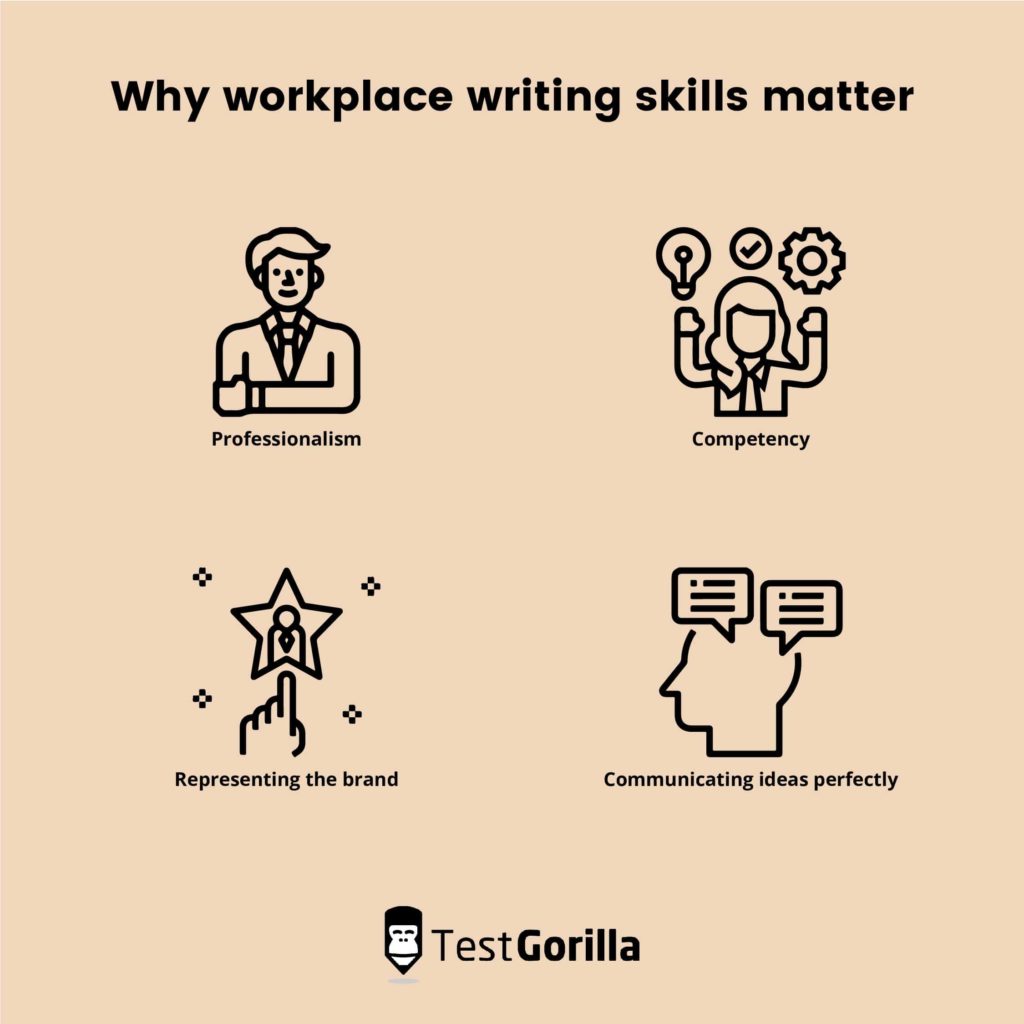Why workplace writing skills are crucial for your employees
Workplace writing skills are essential for all employees in today’s business environment.
First of all, the pandemic has caused a lot of businesses to switch completely to online communication. For these companies, long gone are the days when an employee could simply stand up from their desk, walk to a table across the room, and communicate a message to their colleagues verbally.
The bulk of communication in the workplace today is conducted in written form, and employees need to be well versed in their writing skills if they want to communicate their messages properly.
So with that in mind, let’s see why workplace writing skills matter, how you can spot a good writer, and what good workplace writing looks like.
Why workplace writing skills matter
Workplace writing skills aren’t just essential for writers — they are widely used in all kinds of roles. Your employees still need to file reports, write emails, and send memos, so writing skills are crucial in the workplace.
There are four main reasons it is crucial to have strong workplace writing skills.
1. Professionalism
When your employee is communicating with a customer or client, they need to ensure that their writing is grammatically correct and error-free and that it doesn’t have confusing diction. When your clients receive messages that look professional, they will, in turn, conduct themselves toward your employees and your business in a professional way.
In other words, your customers will take you and your business seriously if they know your employees can write well.
2. Competency
There are almost no roles in today’s workplace that don’t require writing skills. A programmer still needs to write emails to their colleagues; an HR representative needs to write out a standard operating procedure; a sales agent still needs to write proposals to their clients.
Your employees communicate and show their competency through workplace writing skills. Employees need to demonstrate two types of competency in their writing:
Internal competency. When an employee is communicating with their peers, managers, and subordinates, they need to show proficiency when it comes to their writing skills. Poor writing skills will signal to other employees that the person may not be competent enough for the job they’re holding and that they can’t communicate their ideas sufficiently.
External competency. When employees communicate externally, they are not only representing themselves but also your company. So if they have poor workplace writing skills, they aren’t only showing customers their mistakes — they are showing them your business’s mistakes.
3. Representing your brand
Employees are the ones communicating with your clients and customers, meaning they are the ones representing your brand. So having good workplace writing skills is a must for employees who are working and communicating directly with your clients.
According to SHRM, a company of only 100 employees loses an average of $420,000 a year on poor communication and email blunders. For bigger companies, it’s drastically worse — those that have around 100,000 employees lose an average of $62 million a year on poor communication.
4. Communicating ideas perfectly
The last reason employees need to have workplace writing skills is so that they can communicate their ideas perfectly. With the remote workplace becoming the “new normal,” the importance of communicating your ideas effectively without being physically present in the room has risen drastically.
Sure, Zoom calls can help out in some cases, but overusing them for every single topic and discussion can lead to Zoom fatigue, so your employees need to learn how to communicate in written form.
5 ways to spot good workplace writing skills in your candidates
There are certain elements of good writing skills you need to take into account when hiring candidates. You should take notice of the following five aspects of good writing ability during the hiring process so that you know what to look for.
1. They don’t use jargon
The primary reason why business writing is full of jargon is that everyone is using it, and most people learn how to write by modeling others around them. So if managers use jargon in their writing, employees are more likely to use it as well.
Jargon is so heavily used in business writing that there’s even a whole book that covers this exact problem — Why Business People Speak Like Idiots.
Great writers don’t use jargon since they always have their audience in mind. They know that their writing needs to be in clear and understandable terms so that their audience can grasp the message.
“Buzzworthy” might mean one thing to the writer and a completely different thing to the client, so a good writer knows to write without jargon.
2. Their writing is clear
During World War II, blackout orders were a common occurrence in the U.S. A blackout order meant that the public needed to close all windows and doors during the night to block out any lights that might have been on.
This was done to prevent the escape of any light from buildings so that enemy aircraft wouldn’t be able to see where to drop their bombs, potentially saving lives.
One such blackout order was issued in 1942 when Franklin D. Roosevelt was the president. His government wrote the following memo:
“Such preparations shall be made as will completely obscure all Federal buildings and non-Federal buildings occupied by the Federal government during an air raid for any period of time from visibility by reason of internal or external illumination.”
When Roosevelt read the memo, he didn’t send it further but instead told his office to deliver a much simpler and clearer message: “Tell them that in buildings where they have to keep the work going to put something across the windows.”
A good writer writes clearly so that the audience can understand the message.
3. Their writing is concise
The average attention span of a human today is six to eight seconds. That’s even less than a goldfish. So employees with good workplace writing skills know that their writing needs to be concise.
They always ask themselves how they can write to write more by writing less.
Good writers don’t clutter their text, and they use simple words instead of complex ones:
currently now
numerous many
attempt try
assist help
They also know they shouldn’t inflate their text by adding unnecessary words:
due to the fact that because
until such time as until
for the purpose of for
Your employees will have to get their point across in as few words as possible. Nobody wants to read a 1,000-word email that could have been written in 300 words.
4. They break (some) rules
Good writers break some grammar rules to improve the clarity, conciseness, and tone of voice of an article, memo, or email. They know when to use a sentence fragment because people speak in sentence fragments.
Like this one.
They sometimes start sentences with words such as “but,” “and,” and “so.” Even though this might sometimes be grammatically incorrect, they will understand why they need to do it.
Nuanced writing doesn’t blindly follow the rulebook, but it is important to understand the rules and when you can break them. A candidate with great workplace writing skills will know how to do this.
5. They use spacing, paragraphs, and subheads
Did you know that 59% of links shared on social media weren’t even read by the person who shared them? And even those people who actually read the article do it in a specific way.
A reader will very often click on your article and skim through it to see if you have relevant and interesting subheads. If you don’t, they will bounce off (exit) your website. If you do have relevant subheads, they will go back to the top and start reading the article from the beginning.
But poor subheads aren’t the only reason readers bounce — there’s also the famous “wall of text.”
“Wall of text”
Your readers will also bounce if your page has a “wall of text.” — a paragraph that spans more than ten, eleven, or even twelves rows without the author or writer ever hitting the Enter button. This creates a block of text that is hard to read, and most readers can’t easily skim through it. So they skip the entirety of the section that contains the wall of text. With that in mind, you can’t have important information tucked somewhere in a wall of text because readers will miss it. That’s why good writers know the importance of subheads, “white space,” and general structure. Subheads break up content into digestible chunks of information that the reader can process quickly, while “white space” creates enough break lines between paragraphs so that the readers don’t get fatigued.
Since the above was a wall of text and most of you haven’t read it, I will now write the same sentences while using white space to chunk the information into smaller paragraphs.
Your readers will also bounce if your page has a “wall of text” — a paragraph that spans more than ten, eleven, or even twelves rows without the author or writer ever hitting the Enter button.
This creates a block of text that is hard to read, and most readers can’t easily skim through it.
So they skip the entirety of the section that contains the wall of text. With that in mind, you can’t have important information tucked somewhere in a wall of text because readers will miss it.
That’s why good writers know the importance of subheads, “white space,” and general structure. Subheads break up content into digestible chunks of information that the reader can process quickly, while “white space” creates enough break lines between paragraphs so that the readers don’t get fatigued.
A candidate with good workplace writing skills will understand the importance of structuring their articles, memos, and emails well. They will write with the audience in mind, use enough white space and proper subheads, and avoid “walls of text” like the plague.
The best insights on HR and recruitment, delivered to your inbox.
Biweekly updates. No spam. Unsubscribe any time.
How to evaluate your candidate’s writing skills
We have come to the conclusion about now understand the importance of writing skills in the workplace. But now, it’s time to see how we can actually evaluate candidates and take notice of good writing skills.
There are three ways you can evaluate your candidates’ writing skills:
1. Assess them with a pre-employment test
This is one of the best ways to evaluate your candidates’ writing skills. By giving them a pre-employment test, you will see which candidates have the skills to make it through the hiring process.
TestGorilla has many different pre-employment tests in our Test Library that you can use to assess your candidates’ writing skills. Here are just a few of the tests you can use:
2. Give them a writing exercise
You can also give your candidates writing exercises to analyze their writing skills. These can provide you with one piece of the puzzle when it comes to assessing the candidates’ writing skills. However, they may not provide you with the full picture for a couple of reasons:
The candidates can be quite nervous and do a poor job of writing (false negative)
The topic the candidates write about can make a huge difference — someone can write amazing content about one topic and completely fail in another
3. Check their portfolio
Finally, you can check your candidates’ portfolio samples. You can ask them for examples of memos, articles, blogs, or ebooks or even analyze the writing in their CVs and cover letters.
The only problem with portfolios is that they can be edited by someone else and don’t necessarily show you the real style and flow of the candidate’s writing. An article can look completely different after being in the hands of a capable editor. Therefore, a portfolio can give you some insight, but it can’t paint the whole picture.
Evaluate workplace writing skills to get the best candidate
Workplace writing skills are essential for well-functioning and productive individuals in today’s workplace. These skills are important for more than just writers — everyone needs good writing skills in the workplace, from programmers and HR managers to salespeople and marketers.
Here are some ways to gauge workplace writing skills in job candidates:
Pre-employment testing
A writing exercise
Ask for a writing portfolio like newsletters, memos, or blog posts they’ve written in the past
You can find more than 150 scientifically validated pre-employment tests in our Test Library. Try TestGorilla for free.
Related posts
You've scrolled this far
Why not try TestGorilla for free, and see what happens when you put skills first.





















